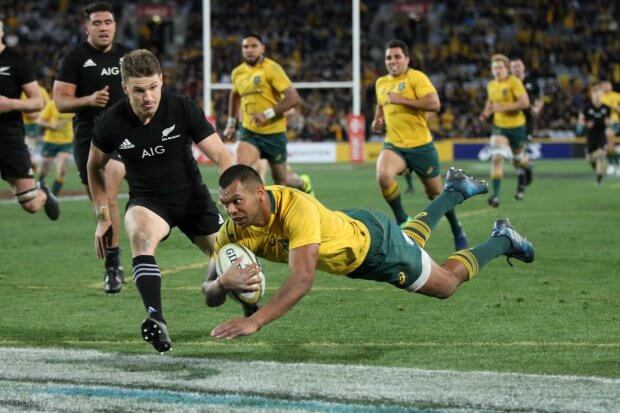The Set Up
As a Wallabies supporter, it’s hard to stomach the result and it’s natural to start grasping at straws to explain what happened. It’s still a bit raw for me, so I’m going to focus on one part of the game where Australia had some sort of parity with the All Blacks. Both teams were well prepared in this area of the game and we’ll take a look at a couple of successful Red Zone plays from both teams. If nothing else, the match last night might provide a couple of new attacking ideas for coaches and players looking to improve their teams effectiveness in this part of their game.
Red Zone (oppositions 22m area)
Generally speaking test matches are often decided by the conversion rate of their Red Zone shots. This was not the case last night but it’s worth noting that New Zealand scored 4 of their 6 first half tries from Red Zone plays and the Wallabies scored 2 of their 4 second half tries inside the All Black’s 22m area. As a student of the game it’s worth having a look to see what tactics each team employed in the Red Zone and we’re going to focus on the following 4 plays.
All Blacks Red Zone Lineout
The first try we’re going to look at was New Zealand’s 5th. They’d already scored from 2 Red Zone shots so this is their 3rd effort, but the 1st from a lineout.
The All Blacks set up a shift drive from the tail of the lineout and then attacked the Wallabies’ try line with runners set up off Aaron Smith. However, instead of hitting their forward runners they used Beauden Barrett out the back, and off the quick recycle Sonny Bill Williams crashed over. Rather than pick and go close to the ruck the All Blacks played with a little more width to chew up more defenders. This ultimately put pressure on the Wallabies’ midfield defenders (Curtis Rona and Henry Speight) who were not up to the task.
All Blacks Red Zone Scrum
The second try we’re going to look at was New Zealand’s 6th. It was a scrum on the left side of the field so they were able to get Aaron Smith in motion with a shape the All Blacks like to use.
It sees Smith run with his 2 centres running hard lines whilst Beauden Barrett slips out the back as a possible link to Damian McKenzie and Ben Smith. The Wallabies’ defence on this play was very questionable, they had Rona protecting Kurtley Beale from Rieko Ioane on the blind side so they were always going to be short of numbers on the open side. The All Blacks double-bluffed the Wallaby midfield defenders (Samu Kerevi and Speight); instead of playing out the back to Barrett they passed in front of Williams to Ryan Crotty, who split the defenders to score.
Wallabies Red Zone Scrum
The Wallabies 1st try was also scored from a left side scrum deep inside New Zealand’s 22m area.
Again the scrum half, in this case Nick Phipps, was used to attack the first defender. But this time the Wallabies chose to isolate Barrett. Tevita Kuridrani who had replaced Kerevi ran a hard line at Barrett causing him to block the run and leave Rona for Ben Smith. Smith had already committed to stopping Phipps and Rona waltzed through the gap to score. Even if Barrett had chosen to tackle Rona it’s doubtful he would have had the momentum to stop the debutant.
Wallabies Red Zone Lineout
The Wallabies 2nd try was scored from a Red Zone drive that shortened up the New Zealand defensive line ensuring they’d be defending inside out, or what is often referred to as “Jockey Defence”.
The Wallabies used a flat set up with Speight and Sean McMahon either side of Bernard Foley and Beale playing out the back of Kuridrani. Foley made a long pass across the face of McMahon and Beale to Kuridrani who tipped on to Israel Folau forcing Anton Lienert-Brown to make a leg tackle. It was a set play that would have also worked against Crotty. Lienert-Brown could only stop Folau in a one on one situation that close to the line by making the leg tackle.
The Wallabies play was designed for Folau to offload to Kuridrani or Beale – and that’s exactly what happened. It was a well designed and executed play.
Summary
There is no doubt that the Wallabies and their coaching team are hurting right now as are all their supporters. It’s frustrating to be so well beaten and the game to be over before half time.
However, in the midst of all the negativity and confusion the coaches have to get the Wallabies back up and ready to play again next week. It’s a leadership challenge and the key is keeping everyone’s nose pointed in the same direction. Michael Cheika has to find a way to turn this around and his assistant coaches have to identify the things they want keep doing and those things they need to fix up. One of the few areas they will want to keep doing in Game 2 is being accurate in the Red Zone.


